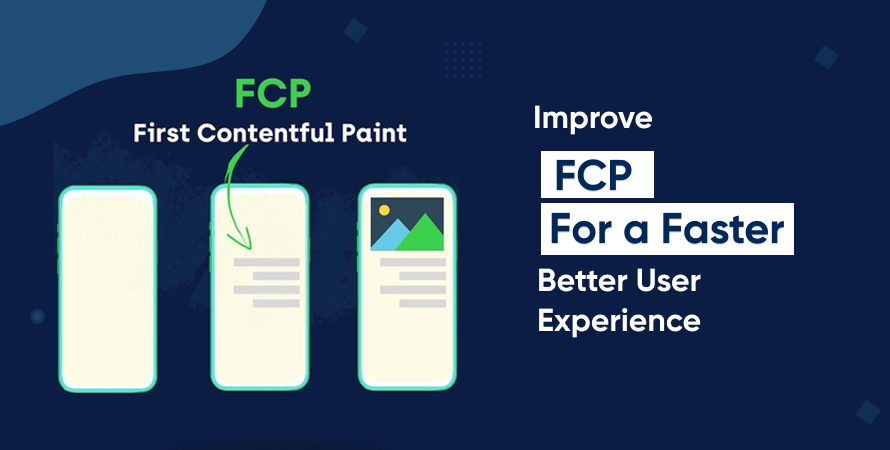Improve FCP for a Faster, Better User Experience



Introduction
In today’s digital-first world, users expect fast-loading, responsive websites. One of the key indicators of a site’s perceived load speed is First Contentful Paint. This core web vitals metric represents the time it takes for a browser to render the first piece of content from the DOM, providing the user with visual feedback that the page is loading.
Google’s emphasis on user experience through Core Web Vitals has made FCP more than just a performance stat—it’s now a ranking factor. Websites that can achieve a good FCP score not only engage users more effectively but also gain a competitive edge in search rankings.
This comprehensive guide covers everything you need to know to improve, optimize, and reduce First Contentful Paint, including insights into JavaScript impacts, benchmarking methods, and actionable optimization strategies used by top-tier digital marketing agencies.
First Contentful Paint- Definition and Calculation
What Does First Contentful Paint Mean?
Definition- FCP means how quickly the browser can render the first piece of DOM content, such as text, images, or SVGs. Unlike time to first byte (TTFB), which tracks when the browser receives the first byte of data, FCP is a more visual, user-focused metric.
How to Calculate FCP
First Contentful Paint is automatically calculated by tools such as Google PageSpeed Insights, Lighthouse, and Chrome DevTools. These tools measure the timestamp between the navigation start and the time when the first content is painted on the screen.
The calculation involves:
- Parsing the HTML
- Requesting and loading CSS and JS
- Painting the first visible element (not necessarily the entire page)
FCP in JavaScript: A Performance Bottleneck
Heavy or unoptimized JavaScript can significantly delay First Contentful Paint. When JS blocks the rendering pipeline, especially during the initial load, it pushes back when the browser can paint content. Understanding FCP in JS-heavy websites is critical to optimizing load times.
FCP vs. Other Web Vitals
While First Input Delay (FID) and Largest Contentful Paint (LCP) measure interactivity and perceived load completeness, FCP reflects the very first visual response. Optimizing FCP is foundational—it sets the tone for everything that follows in the page load process.
What is a Good FCP Score?
Google’s Benchmarks for FCP
According to Google’s Core Web Vitals:
- Good: Less than 1.8 seconds
- Needs Improvement: Between 1.8s and 3.0s
- Poor: More than 3.0 seconds
A good FCP score ensures that users don’t bounce out of frustration, and it increases your likelihood of better engagement and conversions.
How to Check Your FCP Score
Use tools like:
- PageSpeed Insights
- Lighthouse
- WebPageTest
- Chrome User Experience Report (CrUX)
These platforms provide not just the First Contentful Paint time but also specific resource-level diagnostics to help you improve performance.
Factors That Affect FCP (First Contentful Paint)
Understanding what slows down FCP is key to optimization. Here are the main culprits:
1. Render-Blocking Resources
CSS files and JavaScript can block the browser’s ability to paint content. When not deferred or asynchronously loaded, these assets halt progress on rendering the page.
2. Server Response Time
Slow back-end performance, especially in database-heavy applications or poorly optimized hosting environments, can delay the initial response, impacting First Contentful Paint.
3. JavaScript Execution Time
Large or inefficient JS bundles, single-page apps (SPAs), and third-party scripts often interfere with fast FCP by delaying DOM rendering.
4. CSS and Fonts
Heavy CSS files and unoptimized font loading strategies can postpone FCP. Using custom fonts without fallback strategies can cause text to remain invisible during load (FOIT—Flash of Invisible Text).
5. Image Optimization
Uncompressed images or lack of responsive image formats like WebP can significantly delay the paint time, especially on mobile connections.
6. Hosting and CDN
Poor hosting infrastructure and the absence of a Content Delivery Network (CDN) can increase latency, especially for global users.
How to Improve First Contentful Paint (FCP)
Achieving a good FCP score requires both front-end and server-side tuning. Here’s how to optimize First Contentful Paint step by step.
1. Minimize Critical CSS and JavaScript
- Inline critical CSS to prioritize styling above-the-fold content.
- Defer non-essential JavaScript using defer or async.
- Eliminate unused CSS and JS through tree shaking and code splitting.
2. Lazy Load Below-the-Fold Content
Lazy loading defers loading images and resources that are not immediately visible to the user. This reduces the initial payload, helping improve FCP.
3. Optimize Fonts
- Use font-display: swap to prevent FOIT.
- Self-host fonts and preload them.
- Only load the character sets you need.
4. Compress and Resize Images
- Use next-gen formats like WebP.
- Apply responsive sizes using srcset.
- Compress images using tools like TinyPNG or ImageOptim.
5. Reduce Server Response Time
- Optimize your backend code.
- Use fast, reliable hosting.
- Employ caching strategies like server-side rendering (SSR) and content caching.
6. Preload Key Resources
Use <link rel=”preload”> for fonts, critical scripts, and CSS. This gives the browser early hints on what to prioritize.
7. Manage FCP in JavaScript-Heavy Sites
- Use frameworks with server-side rendering (e.g., Next.js).
- Optimize hydration strategies.
- Defer third-party scripts (e.g., analytics, chatbots).
8. Use a CDN
A Content Delivery Network reduces latency by delivering assets from a server close to the user, improving both FCP and overall load time.
Tools to Measure & Optimize FCP
These tools help monitor and reduce First Contentful Paint across different devices and locations:
Google PageSpeed Insights
Provides lab and field data with actionable tips to improve FCP.
Lighthouse
Run audits directly in Chrome DevTools to get FCP measurements and diagnostics.
WebPageTest
Offers filmstrip views and waterfall charts to visually assess when FCP occurs.
Chrome DevTools
Use the Performance tab to record load events and pinpoint delays.
Core Web Vitals Extension
Monitor your site’s performance metrics in real time as you browse.
Common Mistakes to Avoid When Fixing FCP
Even well-intentioned optimization efforts can go wrong. Avoid these pitfalls:
Over-Optimization
Inlining too many resources increases HTML size, which can slow down page loading and hurt FCP instead of helping it. Balance optimization to avoid unnecessary bloat.
Ignoring Mobile Experience
Focusing only on desktop ignores the slower mobile networks and devices where FCP often suffers. First Contentful Paint testing on mobile is essential to ensure a good user experience everywhere.
Third-Party Scripts
Using too many third-party scripts like ads or social widgets can significantly delay rendering, causing poor FCP scores. Manage and limit these scripts carefully.
Not Testing Incrementally
Making multiple changes without testing each one can hide which fix improves or harms FCP. Incremental testing ensures you understand the real impact of each optimization.
Role of a Digital Marketing Agency in Improving FCP
Optimizing FCP is not just a development task—it’s a critical aspect of user experience and SEO strategy. A specialized digital marketing agency offers a multidisciplinary approach that combines technical performance tuning with CRO, analytics, and content best practices.
Such agencies:
- Analyze both front-end and server-side bottlenecks
- Customize solutions for different platforms (e.g., WordPress, Shopify)
- Incorporate FCP optimizations into broader Core Web Vitals compliance
Hiring experts who understand how to calculate FCP, improve performance metrics, and translate them into real business results is often more efficient and cost-effective.
Conclusion
Improving First Contentful Paint is one of the most impactful actions you can take to enhance user experience, reduce bounce rates, and boost SEO performance. Whether you’re a developer, marketer, or business owner, understanding the mechanics behind FCP and implementing best practices will keep your users engaged and your site competitive.
Keeping up with Google’s First Contentful Paint guidelines and regularly auditing your site performance should be a recurring task, not a one-off project.
If you’re looking to dramatically improve your site’s FCP and align with Core Web Vitals standards, consider working with our team of Core Web Vitals consultants for a tailored optimization plan.
Frequently Asked Questions (FAQs)
First Contentful Paint in Google’s Core Web Vitals is a performance metric that measures how long it takes the browser to render the first visible piece of content on a page. A faster FCP improves perceived load speed, user engagement, and contributes to higher search engine rankings.
Google defines a good FCP score as under 1.8 seconds. Pages loading between 1.8 and 3.0 seconds need improvement, while scores above 3.0 seconds are considered poor. Achieving a fast FCP ensures users quickly see content, improving their experience and reducing the likelihood of them leaving the site early.
To reduce FCP, minimize render-blocking CSS and JavaScript that delay painting, optimize server response time for faster delivery, and use lazy loading for below-the-fold content. Also, compress fonts and images, leverage next-gen formats, and implement preloading and code splitting to ensure priority resources load without delays.
FCP in JavaScript-heavy sites is often delayed because JS can block rendering until it finishes executing. HTML can be rendered immediately unless blocked by external CSS or scripts. Minimizing JavaScript execution and using deferred loading techniques can help reduce FCP in JS-dominant environments, improving overall performance.
To fix FCP issues in WordPress, use optimization plugins like WP Rocket, switch to lightweight themes, and reduce reliance on heavy page builders. Convert images to WebP, implement caching systems, and use a CDN to ensure global content delivery is fast and efficient, boosting initial load performance.